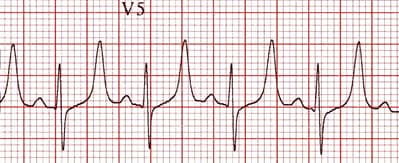Snapshot
- A 22-year-old man presents to the emergency department after a crush injury to his lower extremities. He reports muscular pain, weakness, and palpitations and noticed that his urine is “tea-colored.” On physical exam, there is tenderness upon palpation of his lower extremities and 4-/5 power in the same area. Urinalysis is heme positive. Laboratory testing is significant for a potassium level of 6.5 mEq/L and creatinine kinase level of 1,500 units/L. An electrocardiogram is shown. (Rhabdomyolysis resulting in hyperkalemia)

Introduction
- The major intracellular cation is potassium and magnesium
- cells contain approximately 98% of the body’s potassium
- the sodium-potassium-ATPase (Na+/K+ -ATPase) pump within the cellular membrane maintains this potassium distribution between the intracellular and extracellular compartments
- potassium is the major determinant of the resting membrane potential across the cell membrane
- normal potassium homeostasis is essential for proper action potential generation in muscle and neural tissue
- Normal potassium homeostasis
- determined by
- potassium intake
- intracellular and extracellular potassium distribution
- urinary excretion of potassium
- mainly accomplished by principal cells in the nephron
- determined by
- Disruptions in potassium homeostasis can result in hyperkalemia or hypokalemia
- these disruptions can have a number of clinical consequences
- hyperkalemia
- defined as a potassium level in the blood that is > 5.0-5.5 mEq/L
- muscle and cardiac dysfunction
- muscular symptoms
- myalgias
- muscle paralysis
- chest pain
- cardiac symptoms
- arrhythmias and palpitations
- muscular symptoms
- nausea and vomiting
- parasthesias
- hypokalemia
- defined as a potassium level in the blood that is < 3.5 mEq/L
- muscle and cardiac dysfunction
- muscular symptoms
- abdominal cramping
- muscle weakness and cramping
- cardiac symptoms
- palpitations
- muscular symptoms
- parasthesias
- nausea and vomiting
- hyperkalemia
- these disruptions can have a number of clinical consequences



